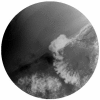Successful closure of chronic recurrent Enterocutaneous fistula with a concurrent over-the-scope closure and a stent placement
- PMID: 32128164
- PMCID: PMC7044360
- DOI: 10.1002/ccr3.2652
Successful closure of chronic recurrent Enterocutaneous fistula with a concurrent over-the-scope closure and a stent placement
Abstract
Gastrointestinal ulcers and perforations can occur as a complication of nonsteroidal anti-inflammatory drugs (NSAID). Emerging endoscopic technologies can be utilized to successfully intervene perforations that fail surgical intervention. We report a case of perforated duodenal ulcer that failed surgical intervention and, however, was successfully closed with over-the-scope clip (OTSC) closure with concomitant placement of fully covered stent.
Keywords: Enterocutaneous fistula; gastrointestinal perforations; nonsteroidal anti‐inflammatory drugs; perforated peptic ulcer; perforations.
© 2020 The Authors. Clinical Case Reports published by John Wiley & Sons Ltd.
Conflict of interest statement
None declared.
Figures
Similar articles
-
Efficacy and safety of over-the-scope clip: including complications after endoscopic submucosal dissection.World J Gastroenterol. 2013 May 14;19(18):2752-60. doi: 10.3748/wjg.v19.i18.2752. World J Gastroenterol. 2013. PMID: 23687412 Free PMC article.
-
Endoscopic treatment of a gastrocutaneous fistula using the over-the-scope-clip system: a case report.Diagn Ther Endosc. 2011;2011:384143. doi: 10.1155/2011/384143. Epub 2011 May 29. Diagn Ther Endosc. 2011. PMID: 21747650 Free PMC article.
-
Over-the-Scope Clip (OTSC) application as rescue therapy for postoperative enterocutaneous fistula closure.Acta Chir Belg. 2014 Jan-Feb;114(1):87-9. Acta Chir Belg. 2014. PMID: 24720148
-
Clinical efficacy of the over-the-scope clip device: A systematic review.World J Gastroenterol. 2020 Jun 28;26(24):3495-3516. doi: 10.3748/wjg.v26.i24.3495. World J Gastroenterol. 2020. PMID: 32655272 Free PMC article.
-
Do perforated duodenal ulcers need an acid-decreasing surgical procedure now that omeprazole is available?Surg Clin North Am. 1992 Apr;72(2):369-80. doi: 10.1016/s0039-6109(16)45684-7. Surg Clin North Am. 1992. PMID: 1549799 Review.
Cited by
-
Over-the-Scope Clip-Associated Endoscopic Muscular Dissection for Seven Cases of Small Gastric Submucosal Tumor: A Video-Based Case Series.Gastroenterol Res Pract. 2021 Mar 19;2021:4578191. doi: 10.1155/2021/4578191. eCollection 2021. Gastroenterol Res Pract. 2021. PMID: 33828588 Free PMC article.
References
-
- Zelickson MS, Bronder CM, Johnson BL, et al. Helicobacter pylori is not the predominant etiology for peptic ulcers requiring operation. Am Surg. 2011;77:1054‐1060. - PubMed
-
- Vasilenko VH, Grebnev AL, Sheptulin AA. Stomach Ulcer. Moscow: Medicine; 1987:288.
-
- Malkov IS, Zaynutdinov AM, Veliyev NA, et al. Laparoscopic and endoscopic management of duodenal ulcers. J Am Coll Surg. 2004;198(3):352‐355. - PubMed
Publication types
LinkOut - more resources
Full Text Sources





